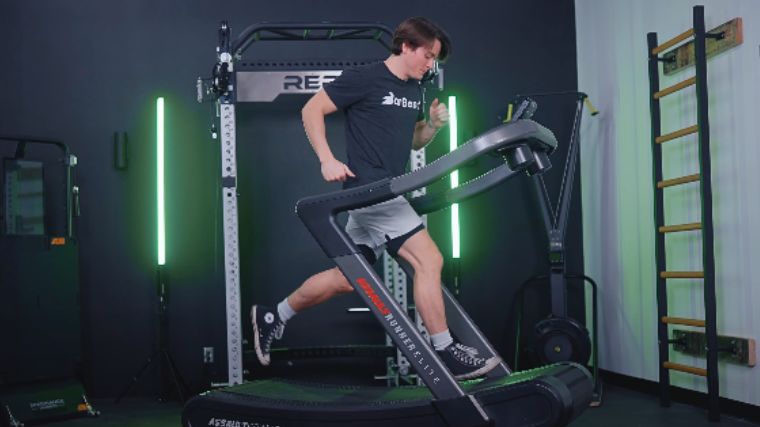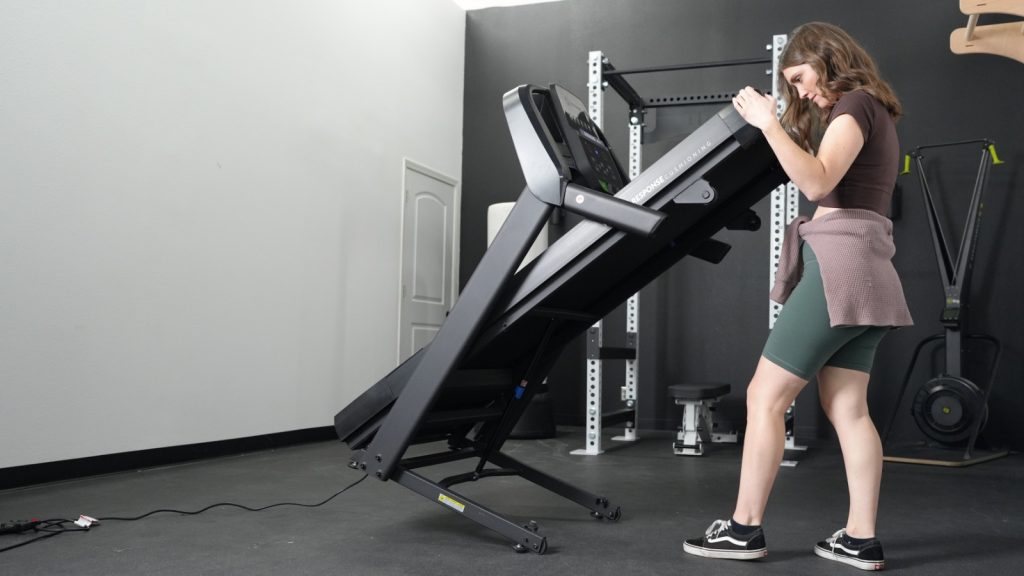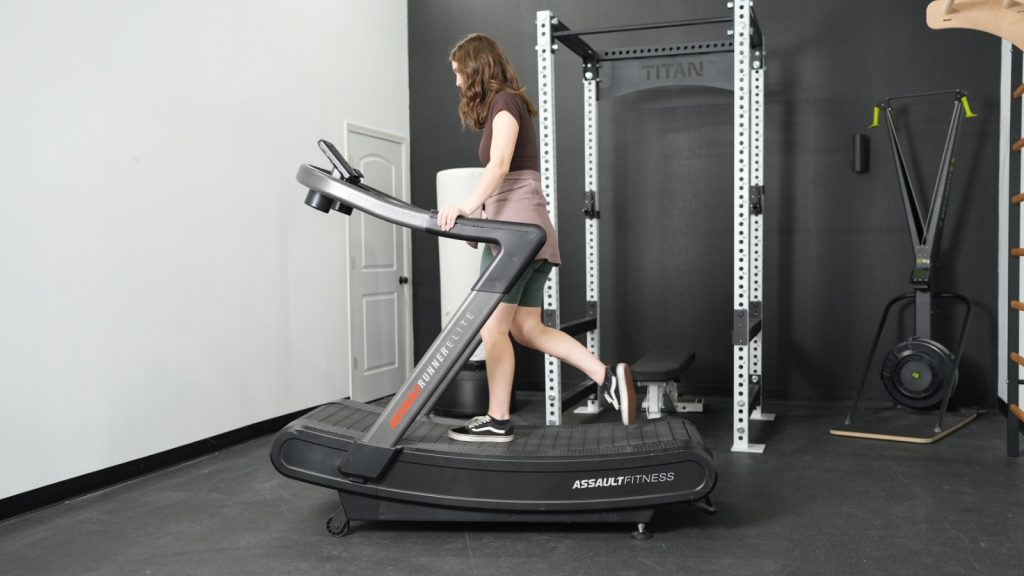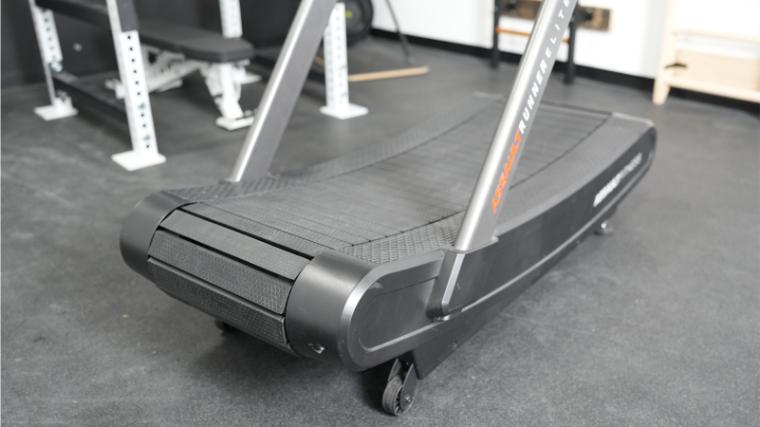Treadmills are a great way to invest in your overall health and fitness. For home users, the best treadmills offer a safe, sturdy means of exercising in the comfort of your own home when walking or running outdoors isn’t an option. For gym owners, outfitting their space with a handful of heavy-duty commercial treadmills offers members a great way to work cardio into their routine in a measured and practical manner.
With that said, purchasing a treadmill is not as simple as going to the store and selecting the first machine you see. Treadmills come in many different types, which can make buying one of these exercise machines a difficult process. As BarBend expert reviewer Amanda Capritto, CPT, CES, CNC, CF-L1, CSNC, notes, buying a treadmill requires research and knowledge: “Finding a treadmill that’s just right for your needs — your Goldilocks — will require some research and knowledge of treadmill specifications.”
In this guide, we’ll be discussing the different types of treadmills available and the pros and cons of each. Continue reading as we provide you with the research and knowledge to purchase the right treadmill for your fitness and budget needs.
Manual Treadmills
As its name suggests, a manual treadmill is a non-motorized, user-powered machine. Instead of running atop a motorized treadmill belt, athletes propel the belt themselves with the power of their own stride.
Since it’s powered by your steps, the belt on manual treadmills moves as fast or as slow as you run or walk. If you’re used to running on motorized treadmills, this can take a minute to get used to. Typically, these machines don’t come with a lot of features that are common on motorized treadmills, like Bluetooth connectivity, integrated fitness apps, customizable settings, training programs, and adjustable inclines.
Although many manual treadmills lack those bells and whistles, they can still offer plenty of benefits. Since you set the pace and move the belt, manual treadmills can better replicate the feeling of running outdoors.
They’re also great for CrossFIT WODs and HIIT workouts, as it’s easier for the user to perform alternating bouts of high-intensity and low-intensity efforts. You can increase and decrease speed quicker on manual treadmills than on motorized ones.
Additionally, they’re easier to position in your home, as they don’t require an electrical outlet for power.
Manual treadmills are designed with both flat belts and curved belts. As we’ll discuss more below, curved belts can help promote a more optimal running form and technique. They also tend to be heavier, sturdier, and more expensive.
| Pros | Cons |
| No electricity needed to operate | Often lacks overall tech features |
| Can better replicate running outdoors | Can take a minute to get used to |
| Come in flat-belt or curved-belt models | Not ideal for long-distance training |
Motorized Treadmills
Motorized treadmills require electricity to power the motor and propel the belt. You’ve likely run on a treadmill with an electric motor before, as these types of machines are common in commercial and home gyms. Motorized treadmills are great for treadmill running, endurance sessions, incline training, and warm-ups and cool downs.
As a long-time personal trainer, I preferred training my clients on motorized treadmills because it was much easier to log their workouts and make appropriate adjustments when needed.

Electric treadmills come in a variety of shapes and sizes and often feature cushioning on the belt deck to help ease the impact on your joints. The best high-end treadmills, for example, tend to feature speed, incline, and decline adjustments, as well as LCD or HD monitors that can track workout data. Sometimes, they can be paired with fitness apps like Peloton or iFIT, allowing users to sweat along to classes or scenic runs.
Commercial builds and tech features will, however, drive up the cost. Additionally, they require placement near an electrical outlet, which could limit home use. These treadmills also take up a lot of space, require consistent maintenance, and can be more dangerous, as the motorized belt increases chances of falls and kids getting too close to the running belt.
If price is an obstacle, then consider checking out a budget-friendly treadmill, which is lower in price than its high-end counterpart. Although budget treadmills lack in some areas compared to high-end electric treadmills, they should still pack enough punch for users of all fitness levels.
In fact, some of the best budget treadmills come with features like incline adjustments, preset workouts, app compatibility, Bluetooth speakers, and more.
| Pros | Cons |
| Typically have adjustable speed, incline settings | Tend to be noisier |
| Great for monitoring and tracking workouts | Increased risk of injury |
| Available in a wide range of sizes, prices | Require electricity |
Folding Treadmills
Folding treadmills are a great choice if you have limited space in your home. “Folding treadmills are a good option for people who need to keep their space multifunctional,” says BarBend expert reviewer Amanda Capritto, CPT, CES, CNC, CF-L1, CSNC. “Treadmills are large pieces of machinery, and in smaller homes, it’s not always feasible to leave a huge piece of equipment lying around. Some people need the floor space taken up by the deck, and folding treadmills fill this gap. When you’re not using the treadmill, you can reclaim the floor space for something else.”
Some of the best folding treadmills can fold up so small that they can then be stowed in a closet or under the bed. Unlike commercial treadmills, they’re built for portability, which means they tend to weigh less and be easier to move around than non-folding treadmills.

One thing you should take into consideration when choosing a foldable treadmill is that the deck securely latches into place when folding. Most modern folding treadmills have hydraulic folding, which makes it easier to fold and unfold the exercise machine and lock into place. Unfortunately, some budget folding treadmills don’t have this feature, which can make them a potential danger, as the deck can fall suddenly if not handled with care.
| Pros | Cons |
| Take up less space when not in use | Durability concerns with lower-priced options |
| Easier to move around | Can be a safety hazard when not properly latched |
| Many options include hydraulic assistance | Some models don’t fold flat, making them harder to store |
Commercial Treadmills
Commercial treadmills are a type of cardio equipment you tend to see in commercial gyms.
“They’re designed to withstand extremely high-volume use and they’re built with the manufacturers knowing hundreds, maybe thousands, of people will use them and not necessarily care for them like they are their own,” says BarBend expert reviewer Amanda Capritto, CPT, CES, CNC, CF-L1, CSNC. “They’re also built with a long lifespan in mind.”
With some treadmills, you can feel them shake or wobble during sprints or high-intensity runs. That tends not to be the case with the best commercial treadmills, as they often have steel builds, strong motors, and weight capacities over 300 pounds.

Additionally, since these machines are designed for a wide range of fitness levels, you’ll often find high max speeds and a wide range of incline.
An overlooked feature on most commercial treadmills is the built-in fan that blows cool air on you while running — you won’t find this on many manual or foldable treadmills. Because commercial treadmills are larger in size, you also tend to get more cup holders and storage space for personal items, like keys, smartphones, books, magazines, or even a tablet.
Convenience really is the name of the game with commercial treadmills. Not only do they have the extra space, but they also have handy features like speed and incline controls on the handlebars and preset treadmill workouts built into the console. Some commercial treadmills even have built-in heart rate monitors on the handlebars.
Unfortunately, they’re also about as expensive as their weight in gold. Commercial treadmills are pricey, too big for most home gyms, and often require specialized technicians to perform complex maintenance work on their powerful treadmill motors and electrical components.
| Pros | Cons |
| Built to support multiple users and daily use | Often too high a price point for the average person |
| Strong, sturdy builds with powerful motors | Take up a lot of space |
| Wide range of customizable settings and workout programs | Heavy, not easy to move around |
Curved Treadmills
As mentioned above, many manual treadmills are designed with a curved running surface. However, you can also find curved belts on some motorized treadmills as well. The curved running deck is often hailed as a better running experience, as it can help improve running technique and increase overall athletic performance. (1)
BarBend expert reviewer Amanda Capritto, CPT, CES, CNC, CF-L1, CSNC, shouted out this unique feature of curved treadmills when discussing the AssaultRunner Pro curved treadmill. “I love how the AssaultRunner encourages me to maintain good running form and feels more like running outdoors, but brings all the benefits of running indoors,” she says.

Running on a curved manual treadmill requires the user to land with a forefoot-to-midfoot strike instead of a heel-strike pattern in order to move the belt. Additionally, this striking pattern brings them closer to their center of mass, promotes maximum hip extension, and has greater activation of the hamstrings and glutes. (1)(2)
This running posture also prompts greater activation of your core muscles to maintain proper balance. Ultimately, a curved treadmill requires users to have optimal running mechanics in order to operate this exercise machine in an efficient manner. This, in the end, will improve one’s running form and performance on or off a treadmill.
Research has also shown that athletes running on a curved manual treadmill can burn more calories than those on motorized treadmills over the same training duration. (3)

The slatted belt you’ll find on the best curved treadmills may also aid with shock absorption, helping reduce the impact on your joints. After logging miles on the TrueForm Trainer, our tester pointed out that the distance between its slats can help disperse the force of each footstrike for a gentler landing. “That thin gap between the slats is a big indicator of its quality,” they said.
Of course, these treadmills are not for everyone. Curved treadmills are more expensive than their flat-belt counterparts, which means that budget-conscious users will be priced out. The sturdy design also makes curved treadmills heavier and harder to move around.
We recommend them for seasoned runners and CrossFit athletes in search of a home treadmill that can support WODs and HIIT workouts. For the average runner interested in staying active and weight loss, a motorized treadmill should suit them just fine.
| Pros | Cons |
| Sturdy machines built to last | Can be very expensive |
| Can potentially burn more calories than on standard treadmills | Large, heavy, and hard to move around |
| Slatted belt can aid with shock absorption | Not ideal for beginners |
Under-Desk Treadmills
If you spend a great deal of time working or sitting at a desk, then one of the best under-desk treadmills could be a fantastic idea. These treadmills are technologically simplistic but perfect for providing users with a practical way to exercise and burn some calories when they can’t escape the home or work office.
“Engaging in more movement is almost never a bad thing,” says BarBend expert reviewer Amanda Capritto, CPT, CES, CNC, CF-L1, CSNC. “An under-desk treadmill is a great way to increase your daily step count and enjoy the benefits of walking. Under-desk treadmills are inexpensive compared to regular treadmills, too. For people on a budget, under-desk treadmills provide a lower-cost option that still allows for great exercise.”

Under-desk treadmills are compact by design, making them easy to slip under your standing desks. Their lightweight (and often foldable) frames are easy to move out of the way if you need to move workstations. Their compact nature, however, means they tend to have lower speed ranges and horsepower than full-sized treadmills. As such, they’re more suited for walking than any running or sprinting.
Some models come with folding hand rails for maintaining balance on the walking pad, but by and large these treadmills lack conveniences, whether that means a built-in monitor, cup holders, or app integration. With that said, finding a quality treadmill for under-desk purposes isn’t difficult. Under-desk treadmills are very affordable and can help to prevent the health ailments that can creep in from a sedentary lifestyle, like obesity and depression. You’ll find several models among our picks for the best walking treadmills.
| Pros | Cons |
| Small enough to fit under standing desks | Limited tech options, no LCD display |
| Ideal for athletes stuck at a desk | Not designed for running or athletic training |
| Budget-friendly with lower price tag | Limited speed and incline settings |
Final Word
When it comes to purchasing a high-quality treadmill, it’s all about making an informed decision based on a variety of personal factors. First and foremost, you’ll want to consider your health needs, fitness goals, and budget. From there, you’ll want to take into account your available space, if you’ve got any curious kids or pets in the home, and if you’re looking for a full-sized treadmill or an under-desk option.
Armed with this knowledge, along with our research on the different types of treadmills, you are well on your way to making an exciting purchase that will provide vital health benefits for years to come.
Types of Treadmills FAQs
What are the differences between treadmills?
When it comes to treadmills, the most significant difference is in how the treadmill is powered. Manual treadmills are powered by the user, meaning that their stride moves the belt forward. Electric treadmills are powered by a motor that moves the belt at a range of different speeds. Other types of treadmills include folding, commercial, and under-desk treadmills.
What is the best treadmill for beginners?
Though everyone is different, we’d recommend an electric treadmill with an adjustable speed range so you can start slow and gradually work your way up to higher speeds. We also suggest models with a selection of preset programs or integration with an app like Peloton or iFIT, as they can help you build a routine. Before picking one up, though, you’ll want to know how much space you have available, how much weight it can support, and what kind of warranty package it offers.
Are curved treadmills better than flat?
Curved treadmills tend to be user-powered machines, meaning it’s on the user to propel the belt with the force of their stride. Since they require the runner to land with a forefoot-to-midfoot strike instead of a heel-strike pattern in order to move the belt, they can promote better running form while also better replicating the feeling of running outside. This doesn’t mean that they are better than flat treadmills, necessarily, but they do provide a different range of benefits.
References
- Hatchett, A., Armstrong, K., Parr, B., Crews, M., & Tant, C. (2018). The Effect of a Curved Non-Motorized Treadmill on Running Gait Length, Imbalance and Stride Angle. Sports (Basel, Switzerland), 6(3), 58.
- McGlashan, Lara. (2024, March 29) A Curved Treadmill Might Just Be What Your Indoor Training Needs. Runner’s World. https://www.runnersworld.com/training/a42083524/a-curved-treadmill-might-just-be-what-your-indoor-training-needs/
- Robertson, N. (2014). Comparing Calorie Expenditure and Rating of Perceived Exertion between the Curve and a Motorized Treadmill. EWU Masters Thesis Collection. 268.